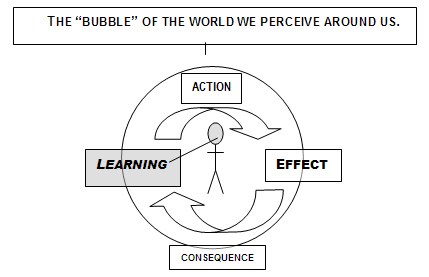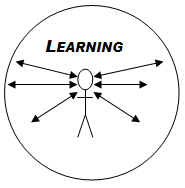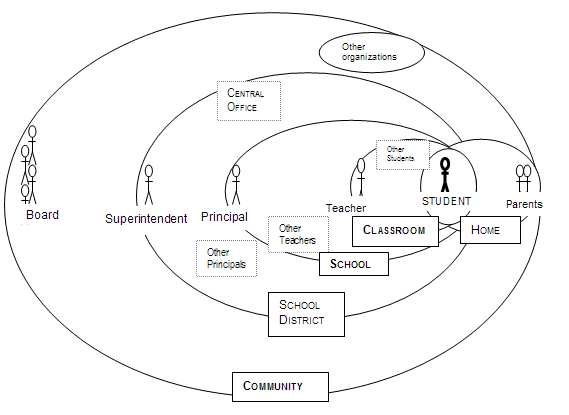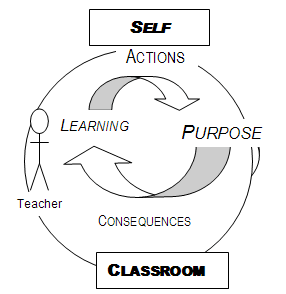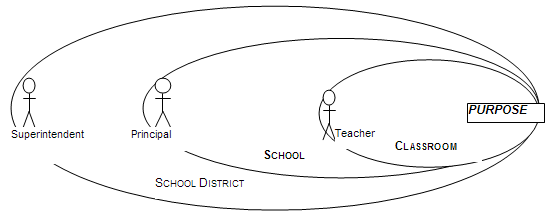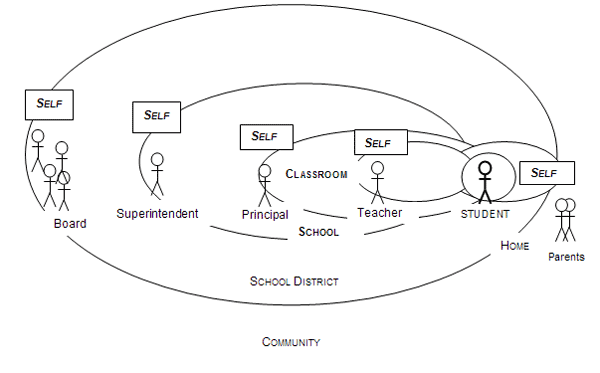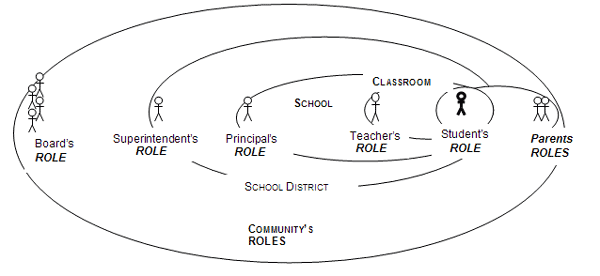Making Sense Through a Systemic Leadership and Management Lens
“If you want to teach people a new way of thinking, don’t bother trying to teach them.
Instead, give them a tool, the use of which will lead to new ways of thinking.” – Buckminster Fuller“It’s never enough to tell people about some new insight. Instead of pouring knowledge into people’s heads, you need to help them grind a new set of eyeglasses so they can see the world in a new way.” – John Seely Brown, Ex-Director of Xerox Palo Alto Research Center
WHAT A THINKING TOOL CAN CONTRIBUTE TO THINKING AND DOING
Both Fuller and Brown were right in my case. I used this different lens as a tool for over a decade to understand what was happening in a major 140,000-student US school system continually responding to all the dynamic social and economic changes facing every urban school district. For me, it offered a different answer to “Why” they were happening and identified unseen possibilities for addressing them that could go to the core of the problem-causing conditions.
Of most importance, it helped me understand why trying to make sense through the prism of the pyramid continued to produce failed strategies for change.
Four unique characteristics of the lens made it possible to “see” and “understand” the products evoked by of this “new way of thinking.” {These are presented in CATCHING THEM DOING SOMETHING RIGHT…)
1. Made Relationship-“seeing” possible+
As a “system-seeing” tool, this lens, in effect, serves as an organizational MRI scanner that sees through practices to the “simple” biological “rules” underlying them at the core level where knowledge created by the brain’s pre-wired learning process begins.
It offers a way to understand, first, how everyone is biologically wired to “make a difference” …and for those in education it’s with children.
Then, with that central purpose, to see how the universal brain-driven need for information becomes the definer of relationships needed for exchanging it, and how these soon become the formal and informal organizational structures needed to sustain those working relationships among interdependent roles the system’s work requires (regardless of the skills of those whose jobs place them in them.)
Because it offers this different view of the tension between “jobs” and “roles” and how work roles in a system relate, it can frame a shared understanding of relationships that can support collaborative actions that weren’t perceived possible before.
2. Portrayed the “work system” as an information-creation and exchange process.
The values of this perspective for strategic leadership and management in schooling are a function of this fundamental nature. Because it portrays the school district as a coherent, connected system of work:
– It offered a simple, visual way to strip away the different meanings of “system” that blur the targets of “systemic” reform, and the words that make it seem like the work of teaching, managing and leading are based on “different” theories and processes. Instead it surfaces the same natural action/learning process that underlies them all.
– It is rooted in the core principles of interaction that actually drive children’s (and adult’s) learning, and makes it possible to focus the alignment of the system’s work to the level where engagement is rooted in the interactions of experience.
– It aligns everyone’s intrinsic need to understand the meaning of their job in terms of how, in the end, their role makes a difference for individual children.
– And because the “picture” it portrayed was coherent and systemically holistic, not only in scope, but also in depth, it offered a different way to see and connect the dots that create their interdependence.
And for me, it offered a way to grasp the coherence and developmental nature of the systemic leadership strategies that have been driving their work for the past ten years.
3. Addressed “Learning” as a capacity, not a product
While it is not unique to focus on children’s learning as the purpose for education, here, the learning that serves at the focusing center of this map is the process of learning, not its products.
It offers a “simple” structure to see through and address the complexities of current information-driven standards, testing, and accountability strategies that are based on learning-as-product. When used, instead, as a means to portray and question education’s Theory-of-the-Business,” its value comes from the core belief embedded in its structure: that “learning” (as a process) is an individual capacity (to be developed), not a product (of that process) that seldom can be connected back to it..
The system’s work then can be seen, understood and managed as the development of each child’s learning capacities through the types of interactions it makes it possible for him/her to be engaged in.
4. Addressed the “Either/Or” “learning disability”
“The best sign of intelligence is the ability to hold good, but contradictory ideas in one’s head at the same time.
Character is to act on two good contradictory ideas.” – James Champy
Most surprising and challenging was that it exposed an inherent learning disability that creates the greatest barrier to the effectiveness of organizational leadership because it directly impacts the thinking of CEO’s, superintendents and other system leaders. This is the system “blindness” caused by the age-old “Either-Or” problem of how to see – and then deal with — the forest and the trees at the same time.
Without a way to address the “Both/And” condition of “complementarity,” as Quantum physicists term it, we often end up focusing our thoughts and resulting efforts on “fixing” people or the system, but not both at the same time. We haven’t believed it was possible and, except for those actually accountable for the success of an entire “system,” didn’t need to think much about it.
The system-view offered by the lens highlighted how the unique requirement of a system leader’s task – to impact a “whole” system – creates a need for ways to get both their mind and hands around it. System’s Thinking and Strategic Planning can meet the first need; but there have been few ways for them to influence the continual tactical thinking that underlies the system’s daily work.
But, as the District’s experience demonstrated, this is not only possible, but it may be the only pathway to sustained systemic change. At the “hands-on” level, the lens’ system view made it possible to connect-the-dots and “see” how the elements of their strategic improvement initiatives were coming together as a strategic management process that could support the tactical problem-solving needs at the varying levels of the district’s work.
(See New Understanding: The Complementarity of Policy and Practice)
Some of the additional insights that emerged from this way of understanding their journey can be found at:
- New Understanding: Decision-making relationships
- New Understanding: A needed Role map
- New Understanding: The X-factor at work.
For me, this tool continues to provide a way to see through what Senge aptly describes as the complex interrelationships of forests and trees by building from the simple, natural principles about how trees grow.
“…the art (of seeing the Forest and the Trees) lies in seeing through the complexity to the underlying structures generating change.
…it means organizing complexity into a coherent story that illuminates the cause of problems and how they can be remedied in enduring ways. …
What we most need are ways to know what is important and what is not important, what variables to focus on and which to pay less attention to.”
What are those natural principles?
CORE PRINCIPLES GROUND INTO THE LENS
One of cognitive biology’s core principles stands at the center of the “world view” this “territorial map” portrays.
In our minds, we each stand at the center of an “environment” in which we try to make a difference.
And our brains are biologically pre-wired to make that possible. The brain provides the OS or “Operating System” that develops and supports the psychological “software” of the mind.
- The continual loop nature of the thinking this common wiring supports is sometimes called “problem-solving,” “trial and error,” or in quality management “PDSA- (Plan, Do, Study, Act.)“
- As noted earlier, this brain, like other body organs, continually produces something essential to the body’s survival – information. It serves not just as an “engine” continually gathering in and initially processing information, but also as an “information pump” that continually seeks social connections from which to access information that can contribute to personal and organizational meaning. And some of the most powerful information is about our own meaning taken in through these interactive social connections with others.
- This continually cycling “loop” serves as the initial “programmer” for the “software” that the mind will continue to develop. This is because the mind, trying to make its job easier, stores some of the information coming in from the brain’s information-processing cycle in beliefs and assumptions (and the “paradigms” they shape) so that it doesn’t have to deal with it each time. But this also can make it harder when a belief-window it creates becomes a “seeing-what-we-believe” filtering barrier to noticing all of what’s actually going on “out there.”
In this “simple” model, this first belief about the brain-as-information-processor serves as the he organizing principle — or as Joel Barker puts it, “The One Thing” – that is the center point of a new sense-making paradigm. Once accepted, it shapes the boundary for a mental model that frames thinking, and becomes the common reference point for making sense of the “puzzle pieces” and “dots” within it. And, functionally, it can be seen as the common root of later processes we call learning, Continual Improvement, and PDSA.
As an example, once one accepts that first belief about this “given” nature of the territory that is the “workplace of schooling,” then its three “work processes” – learning, teaching and schooling — can be aligned to it.
- Learning can be understood as a product of interaction.
Interactions have two ends, and if each child’s learning is a product of his/her interactions, who is the most critical partner in the interaction?
If it is the child, then this means he/she is the co-creator of the “products” of the learning process whose “results” the “system” is held accountable for.
If this is true, and each partner doesn’t have a meaningful role in the process, one might expect to find all the present day conditions that surface as student disengagement and pressures for more “accountability.” How might this alternative view change our thinking about “engagement” processes? What if each child already is engaged, and we haven’t been able to harness that natural energy? For example:
If each child’s learning is a product of his/her interactions, and the most significant inter-actors are those adults who care about them — teachers and parents – then…
- Teaching can be understood as a process of providing the opportunities for those interactions, and access to the information that informs them.
The quality of learning and teaching becomes a function of the frequency and relevance of those interactions.
Does this have implications for change efforts that start with putting a “Quality Teacher” in every classroom? What if what is needed first is a quality teaching process that supports a co-managed, interactive teaching-learning process in every classroom? (see link……)
While it is not unique to focus on children’s learning as the purpose for education, here, the learning that serves at the focusing center of this map is the process of learning, not its products. What are the implications of this way of thinking for dealing with the complexities of current information-driven standards, testing, and accountability strategies that are based on learning-as-product?
And what are the implications for individualization or customization of instruction when the system’s core work can be seen and understood as the development of each child’s learning capacities through the types of interactions it makes it possible for him/her to engage in.
- Schooling – The effectiveness of these caring adults depends to a large extent on the information and support that enables them to make decisions and take actions that are individually responsive to that child’s needs and requirements.
What are the implications of this principle for the development and support of school system leadership and management if the product of their work can be understood as an integrated learning management process? One which
- creates and sustains the core interactions that
- support and inform the school’s work of managing the interactions that
- each child’s individual learning process requires. (see link……)
CONNECTING THE PRINCIPLES TO PRACTICE:
Taking the Knowledge-creating and -using Mind to Work
This OS-like operating “program” is always running beneath the primary mental workplace regardless of the different physical workspaces in which it takes place such as classrooms, buildings, or districts. But at work another factor comes into play.
In those purposeful workspaces, as we focus on a task or job, we now slip over to the side of the bubble and engage the “OS’s” (Operating System’s) common programming to accomplish the purposes of our work. The interactive dynamics and requirements of this cyclical mental process remains the same, however – to reach out, act, learn as quickly as possible from the consequences fed back, and act again.
This process, then, can substitute for the “pyramid” to frame thinking about how mental and physical “workspaces” align to a child’s learning. Note: By changing the reference point of this “map” of the organizational mental “territory,” the fundamental relationships among all the jobs and roles have not changed. If you turn this 900 you can still draw a “pyramid-like map” branching from what now appears as a “top” and “bottom.”
Seems “simple,” but the nature of the continually running knowledge-creating process each person brings to work creates two problem conditions.
1. Duality: “I am my work“/ I perform the System’s work.
Often a duality condition occurs, as the outer boundary of the self in the mind simultaneously overlaps the outer boundary of the physical work setting. We may begin to think of ourselves as our work because our personal sense of meaning and fit at work must usually (and unfortunately) be found within the confines of that physical space.
This consequences of this duality surface (as we shall see) when the “job” one is held accountable for performing bumps up against the “role” that the contextual conditions of one’s place in the system-of-work also requires them to respond to.
2. Interdependent Autonomy
The second problem is created because now one’s supposedly autonomous organizational workplace is often “inside” of someone else’s whose relationship to you is defined by that same common end purpose for which you share responsibility.
And now they have a “problem.” Their capacity to make a personal difference through their work requires that first you can make a difference in yours.
Your mutual problem: you each require autonomy for outcomes for which your job holds you “accountable.” But you “need each other” for those for which your roles share responsibility.
These people, doing their individual work in these simultaneous mental and organizational “spaces,” comprise the “territory” that our organizational “maps” can’t quite capture through the “top-down” or “bottom-up” job pyramids that presently serve as organizational maps.
MAPPING MEANING
With brains and minds pre-programmed to simultaneously seek meaning, two forms of meaning must be taken into account – personal and organizational – and how together they influence each individual action.
Personal meaning
When thinking about the personal meaning of actions by individuals and organizations, each circle represents a mindset within which one continually determines how to make a difference.
Organizational meaning
When this format is used to think about the systemic meaning of decisions we are now looking through the lens of a role map. We see people’s functional roles in the system as opposed to their individual jobs. These are usually interdependent roles that must be performed regardless of who is in the job.
- When used as a “personal” map, this framework can (like a traditional organization chart) still address the system’s need to determine “jobs” that perform the work tasks that need to be done and where. These determine what the system sets competency standards for, hires for, supervises, and evaluates.
- When used as a “role map,” it portrays the roles (regardless of individual competencies) that comprise the system’s capacity to accomplish its purposes, and sustain itself. These “Roles” are determined by the priority of demands the immediate context places on the work to be performed. Roles are usually responsive in nature and played out within constraints of limited time and information. Unfortunately. people often have to work around the system and develop “informal systems” to meet these role demands.
Because the role map portrays a more natural alignment of “jobs” it makes it possible to “see” the connectedness of the system’s sustained “roles” (where the dots need to be connected), and the need to build on these links to develop processes that support the disconnected “jobs” many people currently are held accountable for performing.
It also offers a more appropriate template for envisioning the ideal structure of a system’s work that must be sustained over time.
Moreover, it can serve as a more appropriate template for envisioning the “structure” of work before “restructuring” it. In many ways it offers leaders a missing dimension of “Vision.” Everyone knows about the importance of vision as the attracting “light at the end of the tunnel.” This provides a vision of the present system as the light at this end of the tunnel – the starting point for any change. And it’s a picture in which everyone can find their place.
That’s important because to perform your job you need to know what to do and how to do it. To perform your role effectively you need to know the fit and interdependence of your job and all the others in the system. And have ways to tap into that knowledge.
NAVIGATING WITH THIS MAP OF THE TERRITORY
Like the screen of a radar scope or MRI, this offers a way of seeing and understanding the “given” both/and natural territory on which we create and sustain schools.
It can be used to raise questions about how each person in the system can get personal meaning, joy, and satisfaction from accomplishing the purposes of their work. And, at the same time the other “map” raises questions about how the “system” can organize and support that same satisfying work as part of accomplishing the system’s purpose.
Using this alignment as a strategic lens offers a way of seeing and understanding the natural territory that can:
— capture the “particle and wave” duality of its nature. It can, at one time represent the world from each individual’s view of his/her “job;” and, at another time, the organization’s view of that individual’s interrelated “role” as the whole organization accomplishes its purposes
— suggest why individuals within organizations may act as they do, and
— indicate possibilities for using those natural processes to accomplish both individual and organizational purposes.
As a research tool, this view enables one to apply a core principle of human development — catch-them-doing-something-right — and then use it as a resource to build on. “Right,” in this case being the tapping of natural thinking processes in one’s work.
Elsewhere on this website, CATCH THEM DOING SOMETHING RIGHT describes how this lens was used to ask different questions and to better understand the scope and nature of a specific school system’s work. WHAT CAN BE SEEN…AND LEARNED? begins to present some of the thinking and learning products of that process. More general observations of what the world education looks like from this lens’ perspective will be found at WHAT ELSE CAN BE “SEEN” THROUGH THE LENS.
“One’s destination is never a place,
but rather a new way of looking at things.” – Henry Miller

